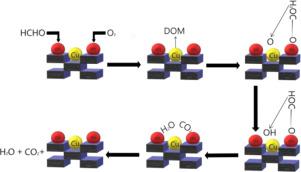当前位置:
X-MOL 学术
›
Chin. J. Catal.
›
论文详情
Our official English website, www.x-mol.net, welcomes your feedback! (Note: you will need to create a separate account there.)
Sodium-treated sepiolite-supported transition metal (Cu, Fe, Ni, Mn, or Co) catalysts for HCHO oxidation
Chinese Journal of Catalysis ( IF 16.5 ) Pub Date : 2020-11-01 , DOI: 10.1016/s1872-2067(20)63599-9 Ning Dong , Qing Ye , Mengyue Chen , Shuiyuan Cheng , Tianfang Kang , Hongxing Dai
Chinese Journal of Catalysis ( IF 16.5 ) Pub Date : 2020-11-01 , DOI: 10.1016/s1872-2067(20)63599-9 Ning Dong , Qing Ye , Mengyue Chen , Shuiyuan Cheng , Tianfang Kang , Hongxing Dai

|
Abstract Sodium-treated sepiolite (NaSep)-supported transition metal catalysts (TM/NaSep; TM = Cu, Fe, Ni, Mn, and Co) were synthesized via a rotary evaporation method. Physicochemical properties of the as-synthesized samples were characterized by means of various techniques, and their catalytic activities for HCHO (0.2%) oxidation were evaluated. Among the samples, Cu/NaSep exhibited superior performance, and complete HCHO conversion was achieved at 100 °C (GHSV = 240000 mL/(g·h)). Additionally, the sample retained good catalytic activity during a 42 h stability test. A number of factors, including elevated acidity, the abundance of oxygen species, and favorable low-temperature reducibility, were responsible for the excellent catalytic activity of Cu/NaSep. According to the results of the in-situ DRIFTS characterization, the HCHO oxidation mechanism was as follows: (i) HCHO was rapidly decomposed into dioxymethylene (DOM) species on the Cu/NaSep surface; (ii) DOM was then immediately converted to formate species; (iii) the resultant formate species were further oxidized to carbonates; (iv) the carbonate species were eventually converted to CO2 and H2O.
中文翻译:

用于 HCHO 氧化的钠处理海泡石负载过渡金属(Cu、Fe、Ni、Mn 或 Co)催化剂
摘要 通过旋转蒸发法合成了钠处理的海泡石 (NaSep) 负载的过渡金属催化剂 (TM/NaSep; TM = Cu、Fe、Ni、Mn 和 Co)。通过各种技术表征合成样品的理化性质,并评估它们对 HCHO (0.2%) 氧化的催化活性。在这些样品中,Cu/NaSep 表现出优异的性能,并且在 100 °C 下实现了完全 HCHO 转化(GHSV = 240000 mL/(g·h))。此外,该样品在 42 小时稳定性测试中仍保持良好的催化活性。包括酸度升高、氧种类丰富和良好的低温还原性在内的许多因素是导致 Cu/NaSep 具有优异催化活性的原因。根据原位 DRIFTS 表征结果,HCHO 氧化机理如下: (i) HCHO 在 Cu/NaSep 表面迅速分解成二甲醛 (DOM) 物种;(ii) 然后立即将 DOM 转化为甲酸盐种类;(iii) 所得甲酸盐物质被进一步氧化成碳酸盐;(iv) 碳酸盐物质最终转化为 CO2 和 H2O。
更新日期:2020-11-01
中文翻译:

用于 HCHO 氧化的钠处理海泡石负载过渡金属(Cu、Fe、Ni、Mn 或 Co)催化剂
摘要 通过旋转蒸发法合成了钠处理的海泡石 (NaSep) 负载的过渡金属催化剂 (TM/NaSep; TM = Cu、Fe、Ni、Mn 和 Co)。通过各种技术表征合成样品的理化性质,并评估它们对 HCHO (0.2%) 氧化的催化活性。在这些样品中,Cu/NaSep 表现出优异的性能,并且在 100 °C 下实现了完全 HCHO 转化(GHSV = 240000 mL/(g·h))。此外,该样品在 42 小时稳定性测试中仍保持良好的催化活性。包括酸度升高、氧种类丰富和良好的低温还原性在内的许多因素是导致 Cu/NaSep 具有优异催化活性的原因。根据原位 DRIFTS 表征结果,HCHO 氧化机理如下: (i) HCHO 在 Cu/NaSep 表面迅速分解成二甲醛 (DOM) 物种;(ii) 然后立即将 DOM 转化为甲酸盐种类;(iii) 所得甲酸盐物质被进一步氧化成碳酸盐;(iv) 碳酸盐物质最终转化为 CO2 和 H2O。



























 京公网安备 11010802027423号
京公网安备 11010802027423号